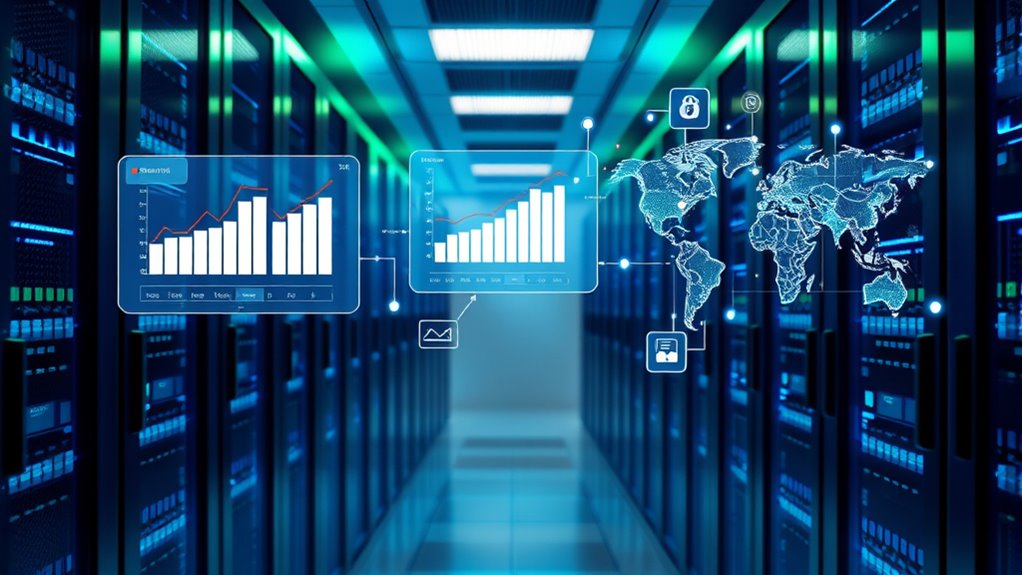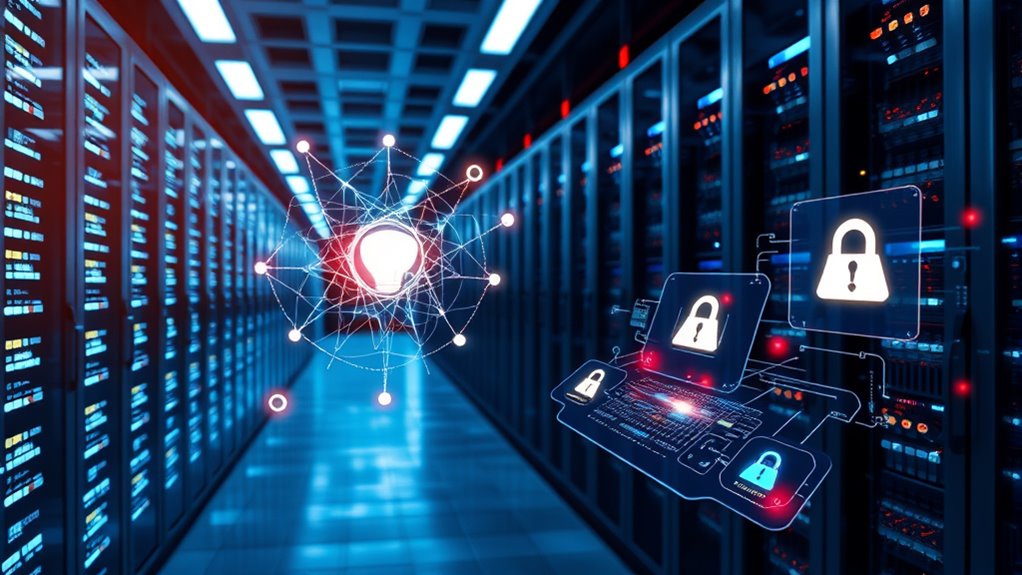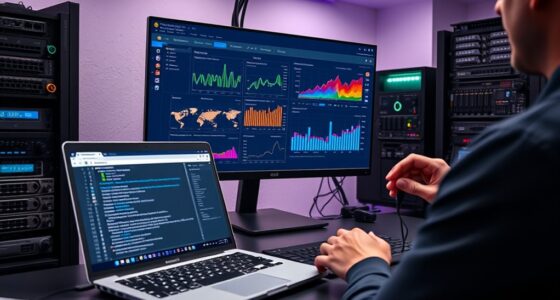AI markedly enhances your cloud security by enabling advanced threat detection through machine learning and predictive analytics. It analyzes vast data streams, identifies suspicious activities early, and adapts to evolving tactics, allowing for proactive measures. Automated responses swiftly contain threats like breaches or misconfigurations, reducing response times from hours to moments. By addressing cloud-specific challenges and filling staffing gaps, AI helps you strengthen your security posture efficiently—discover how these solutions can transform your defenses as you explore further.
Key Takeaways
- AI analyzes vast data to identify suspicious activities early, enhancing threat detection accuracy in cloud environments.
- Machine learning models recognize Indicators of Attack, enabling proactive and adaptive security measures.
- AI-driven automation executes immediate responses, such as isolating threats or patching vulnerabilities, minimizing manual intervention.
- Continuous learning and model refinement reduce false positives, improving operational efficiency and threat prioritization.
- AI helps detect misconfigurations and vulnerabilities in real time, supporting rapid remediation and strengthening security posture.
Enhancing Threat Detection With AI Technologies

AI technologies substantially boost threat detection in cloud security by analyzing vast amounts of data to identify suspicious activities early. You benefit from machine learning algorithms that examine user behavior, network traffic, and system configurations, distinguishing normal patterns from anomalies that could signal threats. Indicators of Attack (IOAs) help AI recognize unusual activity before damage occurs, spotting lateral movements and privilege escalations in cloud workloads. AI continuously updates its models, learning new attack tactics and evasive maneuvers, ensuring detection stays current. By processing data in real time, AI reduces false positives common in traditional methods, allowing you to focus on genuine threats. Additionally, the choice of appropriate projector technology can significantly improve visualization of security dashboards and alerts, aiding faster decision-making. Incorporating real-time analytics further enhances your ability to respond swiftly to emerging threats, minimizing potential damage. This proactive approach enhances your security posture, catching complex and evolving threats before they can cause significant harm. Furthermore, integrating trusted security solutions rooted in proven methodologies can bolster the effectiveness of AI-driven threat detection. Implementing standardized security protocols ensures consistent and reliable defense strategies across your cloud environment.
Real-Time Response Automation in Cloud Environments

Building on advanced threat detection, automating responses in real-time allows your security systems to act instantly against emerging threats. You can leverage your cloud infrastructure and sensors to execute commands remotely, ensuring minimal impact on system performance. Automated tools support investigative actions like data collection and system probing, alongside remediation measures such as process termination or file deletion. These autonomous responses are context-aware and precise, minimizing disruption to legitimate services. Effective incident response processes are crucial for maintaining security posture in dynamic cloud environments. Cloud-native automation supports multi-cloud, hybrid, and container environments, providing extensive, rapid threat containment and remediation. Incorporating automated response orchestration further enhances efficiency by coordinating multiple security tools seamlessly. Additionally, integrating AI-driven analytics can improve the accuracy of threat detection and response decisions, making automation even more effective.
Leveraging Predictive Analytics to Foresee Attacks

Predictive analytics in cloud security helps you identify potential threats before they materialize, using advanced data analysis and machine learning. By analyzing historical data, network activity, and user behavior, you can spot patterns and anomalies that signal an impending attack. This proactive approach transforms your security strategy from reactive to anticipatory, allowing you to neutralize threats early. Additionally, automated security protocols can respond swiftly to detected threats, further enhancing your defenses. Incorporating self-monitoring systems can also improve the effectiveness of threat detection by continuously evaluating system health and security posture. Recognizing the importance of personality traits such as openness to experience can aid in designing more adaptive security measures that anticipate attacker behavior. Moreover, understanding security vulnerabilities in your cloud environment enables you to strengthen defenses against emerging threats.
Predictive Data Analysis
Predictive data analysis in cloud security enables organizations to anticipate and prevent cyber attacks before they happen. By aggregating data from network logs, IoT devices, endpoint activity, and threat feeds, you gain a detailed view of potential risks. Incorporating both structured and unstructured data provides richer context for accurate threat prediction. You clean and preprocess data to eliminate inaccuracies, ensuring your models are precise. This step is crucial for maintaining the accuracy of threat models, which directly impacts detection quality. Additionally, understanding the importance of regular data assessment helps in adapting models to new threats. Dynamic integration of multiple data streams keeps your situational awareness current, supporting real-time analysis. Continual updates from intelligence sources capture the evolving threat landscape. Using machine learning algorithms like decision trees, neural networks, and anomaly detection, you identify attack patterns early. Statistical techniques help you detect behavioral deviations, enabling proactive defenses against emerging threats. Additionally, implementing top cybersecurity practices ensures comprehensive protection and resilience against sophisticated attacks. Incorporating advanced analytics further enhances the ability to foresee and mitigate complex threats proactively.
Anticipating Threat Patterns
By analyzing both historical data and real-time information, you can foresee potential cyber threats before they occur. Predictive analytics shifts your defenses from reactive to proactive, enabling early detection of emerging attack patterns. AI-driven models identify anomalies in network logs, user behavior, and threat feeds, signaling possible threats like unusual login attempts or lateral movements. Integrating diverse data sources, including external intelligence, enhances prediction accuracy, especially against advanced persistent threats. Continuous learning allows your systems to adapt to evolving tactics, maintaining effectiveness. By focusing on contextual anomalies, you reduce false positives and prioritize critical alerts. Developing a comprehensive threat detection strategy ensures that your security measures remain robust against sophisticated cyberattacks. Automated risk assessments and response suggestions streamline your security operations, helping you allocate resources efficiently and respond swiftly to emerging threats before they cause harm. Additionally, leveraging specialized security tools can further refine detection capabilities and improve response times. Incorporating AI trend insights from platforms like AI News can also inform your strategy with the latest developments in threat prediction and defense techniques.
Reducing False Positives for Accurate Alerting

Reducing false positives in cloud security alerts is essential for maintaining effective and efficient threat detection. AI-driven solutions analyze multiple contextual factors—such as user behavior and historical activity—to improve threat accuracy. Behavior-based anomaly detection establishes baseline patterns, enabling personalized risk scoring and subtle deviation detection. Adaptive threshold management adjusts detection sensitivity based on observed patterns and feedback from security analysts, minimizing unnecessary alerts. Predictive analysis forecasts potential attacks, allowing proactive responses that reduce false positives. Real-time threat detection spots anomalies instantly, preventing attacks before they escalate while keeping false alarms low. Additionally, integrating vetting processes ensures that only credible alerts prompt action, further reducing false positives and enhancing overall security posture. Incorporating machine learning techniques can further refine detection capabilities by continuously learning from new data, thereby increasing the precision of threat identification. Moreover, understanding the interconnectedness of individual and collective energy helps security teams recognize patterns that might otherwise be overlooked, leading to more accurate threat assessments. Implementing these advanced methods creates a more robust and reliable security environment that adapts to evolving threats.
Increasing Operational Efficiency Through AI Adoption

By automating threat responses, you can cut down manual work and respond to incidents in seconds instead of hours. AI streamlines routine tasks, freeing your security team to focus on more complex issues. This combination boosts your overall security precision and operational efficiency. Incorporating vetted product reviews can help you select reliable AI tools tailored for your needs. Additionally, understanding the regional legal resources available can aid in ensuring compliance and effective incident management. Leveraging state-specific incentives can further optimize your security investments and compliance strategies.
Automating Threat Responses
How can organizations respond to cloud threats more swiftly and effectively? AI makes this possible by automating responses to detected threats in real time. When AI identifies issues like unauthorized access or misconfigurations, it acts instantly—blocking malicious IPs, isolating compromised workloads, and patching vulnerabilities—without human delay. This drastically cuts incident response times from hours or days to seconds or minutes, reducing breach impact. AI-driven automation also enables rapid scaling across multi-cloud environments and supports orchestration of containment and remediation actions. This boosts operational efficiency and minimizes the need for manual intervention.
- Block malicious IP addresses automatically
- Isolate compromised workloads instantly
- Patch vulnerabilities proactively
- Support rapid deployment across clouds
- Orchestrate response actions seamlessly
Reducing Manual Workload
Adopting AI-driven automation transforms cloud configuration management by continuously monitoring settings and promptly flagging misconfigurations. This reduces your reliance on manual audits and static policies, enabling real-time detection of issues like overly permissive IAM roles or exposed storage buckets. AI can suggest remediation steps and sometimes apply fixes automatically, maintaining secure baselines without human intervention. This streamlines operations, minimizes human error, and accelerates the correction of common security risks. Additionally, automation decreases the time you spend on repetitive security configuration checks, freeing your team to focus on strategic tasks. By automating routine tasks, AI enhances operational efficiency, ensures consistent security standards, and reduces the workload associated with manual oversight—making your cloud environment safer and more manageable.
Enhancing Security Precision
AI-driven automation not only streamlines security management but also substantially enhances the precision of threat detection in cloud environments. You’ll notice a 60% increase in detection accuracy, cutting down false positives and helping you prioritize real threats. Indicators of Attack (IOAs) analyze user and network behaviors to identify sophisticated attack vectors early. Machine learning models adapt continuously, improving their ability to classify threats and predict emerging risks. Organizations using AI have reduced breach containment times from over 300 days to about 214, boosting response speed. Plus, AI’s real-time data processing detects threats within seconds, allowing rapid intervention.
- Improve threat detection accuracy and reduce false alarms
- Analyze behavioral patterns for proactive threat identification
- Continuously adapt detection models to evolving threats
- Accelerate breach response from days to seconds
- Enable swift, automated threat mitigation
Addressing Cloud-Specific Security Challenges

Addressing cloud-specific security challenges requires a targeted approach to manage unique risks such as data breaches, misconfigurations, and identity vulnerabilities. Data security remains a top concern, with 63% of organizations worried about leaks and unauthorized access. Over 45% of breaches occur in the cloud, often linked to misconfigurations, which cause 82% of incidents. Managing secrets, like credentials, is another vulnerability, as many contain exposed secrets, increasing attack risks. Complex multi-cloud setups make consistent security policies difficult, heightening misconfiguration chances. Identity management issues, including inconsistent IAM policies and exposed service accounts, expand attack surfaces. To counter these challenges, leveraging AI-driven threat detection and automated responses becomes essential, enabling quicker identification and remediation of cloud-specific vulnerabilities.
Protecting Multi-Cloud and Hybrid Environments

Managing security across hybrid and multi-cloud environments introduces unique challenges due to their inherent complexity. You face diverse identity models, policy languages, logging methods, and control frameworks, which hinder unified enforcement and create oversight risks. Conflicting configurations, like encryption defaults and identity federation, can lead to security gaps exploitable by attackers. Fragmented tools and reactive policies limit visibility and consistency, making it harder to detect threats promptly. Additionally, varied DevOps pipelines increase misconfiguration risks. To address these issues, you need:
- AI-driven tools to unify telemetry and threat detection across platforms
- Automated policy enforcement to reduce human error
- Continuous compliance monitoring for regulatory alignment
- Automated audits of permissions and configurations
- Real-time correlation of data to identify vulnerabilities and respond swiftly
Combating Staffing Shortages With Automated Monitoring

As staffing shortages continue to challenge cloud security teams, automated monitoring becomes essential for maintaining visibility and rapid threat detection. You need tools that offer real-time insights and reduce reliance on limited human resources. Automated telemetry, especially network-derived data, is considered critical by 80% of organizations. Nearly two-thirds plan to prioritize real-time monitoring by 2025, but 64% still lack confidence in threat detection across all cloud environments. To address this, AI automates anomaly detection, quickly flagging suspicious activities like unusual logins. This scalability helps bridge the skills gap—76% report shortages—while reducing manual workload. Use the table below to understand key automation efforts:
| Focus Area | Impact |
|---|---|
| Threat Detection | AI enhances real-time threat identification |
| Policy Enforcement | Automated security policies ensure compliance |
| Scalability | AI solutions grow with organizational needs |
Improving Security Posture in Cloud Computing

The rapid growth of cloud adoption has greatly heightened the importance of maintaining a strong security posture across diverse environments. You face increased risks from misconfigurations, especially in complex multi-cloud setups. To improve your security, focus on adopting automated Cloud Security Posture Management (CSPM) tools driven by AI. These tools help you continuously monitor for vulnerabilities, enforce compliance, and respond swiftly to threats. Incorporating AI enhances real-time analysis, reducing human error and speeding incident response. As cloud environments grow more intricate, automation becomes essential for maintaining visibility and control. Keep in mind:
Automated AI-driven CSPM is essential for securing complex multi-cloud environments and ensuring continuous compliance.
- Multi-cloud environments demand advanced visibility
- Automated CSPM detects misconfigurations early
- AI speeds threat detection and response
- Regulatory pressures push toward continuous monitoring
- Investments in AI strengthen overall security posture
Frequently Asked Questions
How Does AI Adapt to Evolving Cyberattack Techniques in Cloud Environments?
You leverage AI’s continuous learning capabilities to stay ahead of evolving cyberattack techniques. It analyzes vast data, identifies new threat patterns, and adapts detection criteria in real time. AI’s unsupervised and transfer learning help it recognize emerging tactics, including AI-driven social engineering and phishing. By constantly updating its models, AI anticipates and responds to sophisticated attacks, ensuring your cloud environment remains protected against even novel threats.
What Are the Limitations of AI in Cloud Threat Detection?
You might think AI can catch every threat, but it has clear limits. False positives flood your alerts, causing fatigue, while false negatives let real threats slip through, especially new or clever attacks. Its “black box” nature hampers trust, and adversaries exploit AI vulnerabilities with sneaky tricks. Plus, data privacy, high costs, and constant upkeep make relying solely on AI risky. Recognize these gaps to strengthen your security stance.
How Does AI Ensure Data Privacy During Threat Analysis?
You can trust AI to protect your data privacy during threat analysis by using techniques like differential privacy, federated learning, and homomorphic encryption. These methods guarantee your raw data stays anonymous, decentralized, and encrypted, preventing exposure. Additionally, strict data governance, access controls, and continuous monitoring help minimize privacy risks, so your sensitive information remains secure while AI detects threats effectively.
Can Ai-Based Systems Replace Human Security Analysts Entirely?
AI-based systems can’t substitute human security analysts entirely because they lack the contextual understanding, ethical judgment, and creative problem-solving humans provide. While AI accelerates threat detection and automates routine tasks, it still relies on human oversight to interpret complex scenarios and ensure fairness. You need a balanced approach, where AI enhances your team’s capabilities, but humans remain essential for nuanced decision-making and ethical considerations.
What Are the Costs Associated With Implementing AI in Cloud Security?
You’ll face initial costs ranging from $10,000 to over $1 million, depending on your system’s size and complexity. Ongoing expenses include cloud storage, model retraining, and security team support, which can total $5,000 to $20,000+ annually. Additional hidden costs like data transfer fees, vendor lock-in, and managing unused models also add up. Budget for audits, tool licenses, and potential downtime to guarantee your AI in cloud security stays effective and cost-efficient.
Conclusion
By embracing AI, you enhance threat detection, automate responses, and predict attacks before they happen. You reduce false positives, increase operational efficiency, and strengthen your security posture. You protect multi-cloud and hybrid environments, combat staffing shortages, and adapt to evolving threats. With AI, you streamline processes, safeguard assets, and stay ahead of cyber risks. Ultimately, AI transforms your cloud security into a proactive, resilient, and intelligent defense system.









